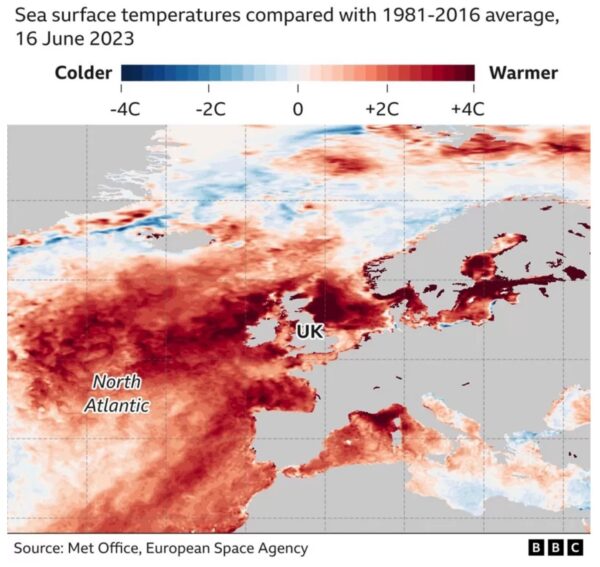Some of the most intense marine heat increases on Earth have developed in seas around the UK and Ireland, the European Space Agency (Esa) says.
Water temperatures are as much as 3 to 4C above the average for this time of year in some areas, according to analysis by Esa and the UK Met Office.
The UK Met Office says the reason is partly human-caused climate change. But other, less-understood natural and man-made factors appear to be driving temperatures up further, the BBC reported.
The Esa data shows sea water around virtually the entire coastline of the British Isles is warmer than usual.
Category 4 – extreme marine heatwave
The North Atlantic Ocean has experienced record-breaking temperatures for the past three months, with average surface temperatures peaking on 17 June at 23°C (73.4°F), 0.2°C above the previous high set in 2010.
Much of the heat is currently concentrated on waters surrounding the UK and Ireland, with scientists at the US National Oceanic and Atmospheric Administration categorising the region as being hit by a category 4 (extreme) marine heatwave, New Scientist reported.
Waters off the UK’s east coast, from Durham to Aberdeen, and off the west coast of Ireland are especially warm. Off Seaham, on the coast of Durham, water temperatures on 18 June hit 15°C, well above the 12°C average for the time of year.
Oceans hit by a quadruple whammy
The number of heatwave days rose by more than 50% in the 30 years to 2016, compared with 1925-54. Scientists said at the time the heat destroyed swathes of sealife “like wildfires take out huge areas of forest”.
The Guardian reported that Piers Forster, a professor of climate physics at the University of Leeds, said: “Both Met Office and NOAA analyses of sea-surface temperature show temperatures are at their highest ever level – and the average sea-surface temperature breached 21C for the first time in April. These high temperatures are mainly driven by unprecedented high rates of human-induced warming.
“Cleaning up sulphur from marine shipping fuels is probably adding to the greenhouse gas driven warming. The shift towards El Niño conditions is also adding to the heat. There is also evidence that there is less Saharan dust over the ocean this year. This normally reflects heat away from the ocean. So in all, oceans are being hit by a quadruple whammy – it’s a sign of things to come.”
